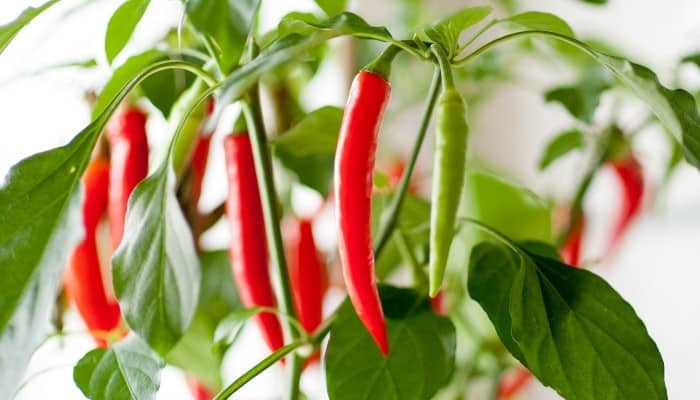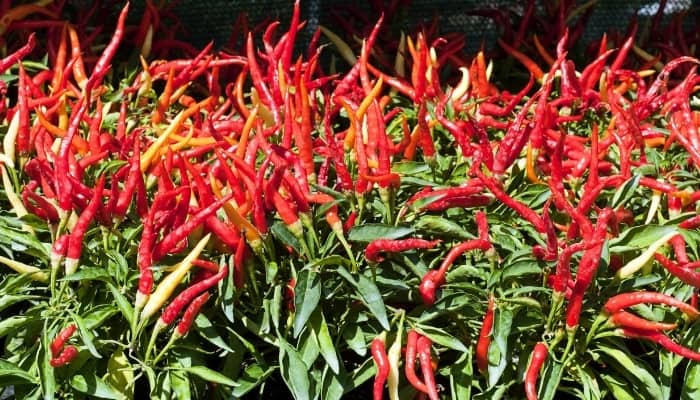It may be surprising to learn that chili peppers are actually part of the berry fruit family and thrive in warm climates. Even if you’re experiencing difficulties currently, you’ll be pleased to know that growing chili peppers in your garden is simpler than you might expect.
The key is to create the ideal environment. Once that’s accomplished, you can sit back and wait for nature to take its course and provide you with loads of tasty peppers.
How can you get chili plants to flower and start producing fruit? A major factor that triggers flowering is temperature. Chilis need temperatures of at least 50°F to flower. Provide full sun and plenty of water. For best results, add nutrients in the form of low-nitrogen fertilizer or compost, check for pests and disease, and suppress weed growth.
If all the right conditions are present, chili plants will start producing flowers sometimes in the spring. You can also accelerate this process by stopping fertilizer use to cause nitrogen levels to drop.
Fruits will appear if pollination takes place during the flowering stage. You can help by gently shaking the chili plants or pollinating by hand.
Read on to learn more about plants from the Capsicum genus and how to grow chili peppers at home.
How To Encourage Flowers on Chili Plants
Chili pepper plants grow small white flowers in the spring and summer. If pollination doesn’t occur within a few days, the flower will dry and make room for a new bud.
The more flowers a chili plant produces, the more chances you have of seeing them turn into peppers.
1. Plant at the Correct Time To Avoid Cool Temperatures
Chili pepper plants do well in warm weather. They need an ambient temperature of at least 50°F and a soil temperature of 60°F or higher.
It means you have to time when you plant them to protect them from the last frost.
You should start germinating seeds indoors six to eight weeks before the last frost in your area. Keep your seeding tray in a warm spot.
Wait two to three weeks after the last frost to move your seedlings outdoors. Chili peppers can grow well in Zones 3 through 11, but you might want to keep these plants inside if you live in a colder area.
2. Apply Fertilizer
A 5-10-10 fertilizer (find it here) or similar will provide your chili pepper plants with all the nutrients they need.
This popular fertilizer mix includes nitrogen for foliage growth, phosphorus for healthy roots and blooms, and potassium to make plants more resistant to pests and diseases.
Note that nitrogen promotes leaf growth, which means the plant will focus its energy on growing its foliage.
Once your chili pepper plant reaches 3 feet in height, you can reduce how much nitrogen you use to promote flowering.
Another trick is to mix Epsom salt with some water to introduce more magnesium, an essential nutrient for flowering.
3. Add Compost
Depending on the quality of your soil, compost can be an excellent alternative to using fertilizer since it’s rich in nitrogen, phosphorus, and potassium.
Besides providing chili pepper plants with essential nutrients, compost can:
- Balance the pH of the soil.
- Loosen the soil to help with root growth.
- Create clumps if the soil is too loose.
- Retain water to create a moist environment.
4. Make Sure Plants Are Receiving Enough Light
Plants from the Capsicum genus need plenty of light. You’ll get more flowers and more fruits if your chili pepper plants have plenty of sun exposure.
If you grow these plants indoors, make sure they get at least 12 hours of artificial light a day (use grow lights to provide full-spectrum lighting plants need).

5. Water Consistently
Pepper plants need a lot of water, but they’re also susceptible to root rot.
You should water every other day and make sure the soil has enough time to dry. It’s essential to plant in an area with good drainage.
6. Suppress Weeds
Weeds will compete with other plants for water and nutrients. They can also restrict root growth. You’ll have to remove weeds so that chili pepper plants have enough room to grow.
You should also place chili pepper plants 30 to 36 inches apart.
7. Check for Pests & Disease
Several insects can feed on leaves, stems, and fruits. These pests include:
- Thrips.
- Aphids.
- Leafminers.
- Whiteflies.
- Psyllids.
- Flea beetles.
- Cutworms.
- Corn borers.
- Fruitworms.
Keep seedlings inside to protect them. They’re particularly vulnerable to flea beetles and cutworms.
You can safeguard adult plants from insects by using pesticides or introducing natural predators.
You should also watch for common diseases that affect pepper plants, including the mosaic virus, southern blight, mildew, and bacterial leaf spot.
Here are some of the symptoms you should watch out for:
- Curled leaves.
- Dropped flowers.
- Stunted growth.
- Dried fruits or dried leaves.
You can remove affected stems or remove entire plants to prevent diseases from spreading.
8. Pick Fruit Often
You should pick peppers as soon as they are ripe. They will fall off and rot if you don’t, attracting insects, bacteria, and fungus.
Besides, picking fruits often means you’re making room for new flowers to grow, which will result in more fruits.
9. Gently Shake the Plants To Aid Pollination Once Flowers Appear
Chili pepper plants are self-pollinating. It means they don’t need to have another nearby plant for pollination.
However, you might have to hand pollinate your plants. Pollen has to get from the anthers, which are sac-like structures on the stamen of the flowers, to the stigma in the center of the flower.
You can gently shake the plant to get the pollen to fall into the stigma or use a cotton swab to deposit pollen in the stigma.
If you hand pollinate your plants, wait until the afternoon when flowers are producing more pollen.
What To Do if Pepper Plants Flowers Are Falling Off
There are different possible solutions if your chili pepper plant flowers are falling off:
- The temperature might be an issue. If possible, move the plants to maximize sun exposure.
- Not providing enough water or failing to water regularly can cause flowers to fall off. It’s also best to water at the base of the plant to avoid weighing the flowers down.
- High nitrogen levels can result in foliage growth and unhealthy buds. Compensate by introducing more phosphorus.
- Check the plant for signs of disease or pests.
Tips for Growing Chili Peppers in Pots
You can grow healthy chili pepper plants in containers. In fact, it’s best to keep these plants in pots indoors if you live in a cold area. Here are a few tips:
- You should use a large container to give the plant plenty of room for growing its root system. Look for a container with a diameter of 12 inches or larger.
- Use a quality potting mix and supplement it with fertilizer. However, measure quantities carefully since nitrogen levels can increase quickly in a container.
- Water every other day and make sure the container has plenty of drainage.
- Move the container to maximize sun exposure. Place it outside during the day and bring the plants inside at night to protect them from cold temperatures.
Related Questions:
There is more you should know about growing chili pepper plants.
What Triggers Pepper Plants To Flower?
Flowers will appear once all the right conditions are present. Chili pepper plants need sufficient sun exposure, warm temperatures, and enough nutrients.
One of the things you can do to trigger flowering is reduce nitrogen levels and introduce more phosphate.
When Do Pepper Plants Flower?
You’ll see small white flowers appear in the spring and summer. Chili pepper plants will keep producing more flowers until the very end of summer or even into early fall.
When temperatures start cooling, you’ll notice a drop in flower production, and when the first frost hits, the plants will die.
Conclusion
You can get chili pepper plants to flower by creating the right conditions, including plenty of sun exposure, warm temperatures, frequent watering, and healthy nutrient levels.
Once flowering and pollination occur, prepare for a good harvest!
You’ll likely have plenty for all kinds of tasty dishes, homemade hot sauce, and dried spices – as well as extra for sharing with friends and family.
Sources:
https://www.gardeningknowhow.com/edible/vegetables/pepper/growing-chili-pepper-plants.htm
https://www.compostingcouncil.org/page/PlantGrowthBenefits
https://www.gardeningknowhow.com/edible/vegetables/pepper/common-pepper-plant-problems.htm
https://www.gardeningknowhow.com/edible/vegetables/pepper/pepper-blossoms-falling-off.htm
https://www.eatingwell.com/article/290757/how-to-grow-peppers-in-a-pot/

